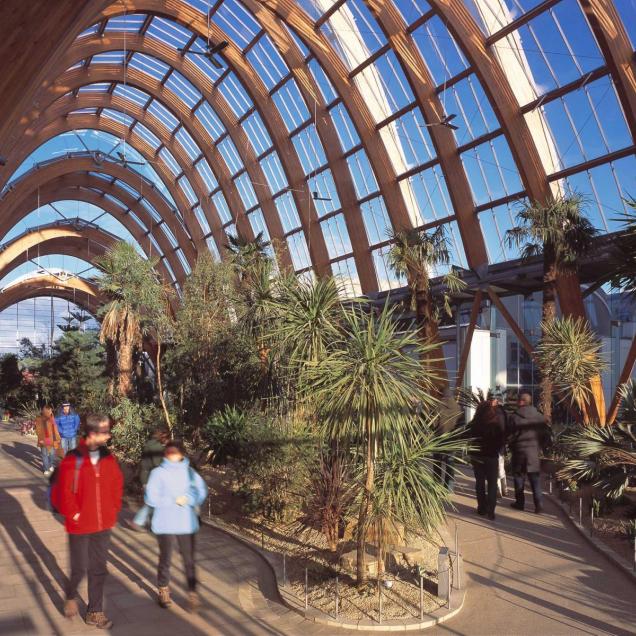

New pounds 70m Winter Garden gives Sheffield a city centre and a
SHEFFIELD HAS underlined Britain's end-of-century obsession with vast botanical glasshouses by making one of Europe's largest the centrepiece of its remarkable post- industrial reincarnation.
The city's Winter Garden, an avenue topped off with larch-framed arches, follows Cornwall's Eden project, Bristol's Wildwalk and the National Botanic Garden of Wales on the pounds 100m list of gardens and glasshouses funded by the Millennium Commission.
Municipal leaders hope the project will provide new focus for an undulating, disconnected city centre, which was tarnished by brutal 1960s architecture such as the notorious city council "eggbox" and by Meadowhall, one of Britain's biggest out-of-town shopping complexes, which drew cash and prestige away.
Now the long climb from the city's railway station is worthwhile because at the top is the Winter Garden, the pounds 70m glass creation of architects Pringle Richards Sharratt that is the new route through to the city centre. That route takes in the city's Millennium Galleries - the art space that has become the Victoria and Albert Museum's northern outpost - and the outdoor Peace Garden, a curving European-style grand central square.
The decision to make a garden the centre of Sheffield's plans is rooted in history. As well as bringing steel and cutlery to the nation's dinner tables, the South Yorkshire city also created one of Britain's first botanical gardens in 1836, characterised by three interconnecting glass pavilions.
The new glasshouse is packed with 2,500 plants of 150 species, including relative obscurities such as the Abyssinian banana (one of the world's oldest cultivated plants) the Japanese Yew and the Norfolk Island Pine, which grows to 150ft. The plants, mostly from the Southern Hemisphere, have been prepared for life in Sheffield with a period of 18 months in greenhouses in south-west England. The new greenhouse's underfloor heating will protect the exotics from winter frost and the surrounding buildings will protect them from the sun in summer.
Sheffield's redevelopment - slow by comparison with nearby Leeds - was being purposely built around its city centre, said Bob Kerslake, Sheffield council's chief executive and an active player in the Core Cities campaign to raise the profile and performance of England's leading cities. "We have identified the need to establish a centre on which everything can grow," he said "It's about creating a powerful cultural and retail environment - not just jobs."
But enticing the commercial sector into the adjoining commercial space to create jobs is the most difficult aspect. Plans for a hotel have provoked controversy because many locals say it will spoil the view from the new Winter Garden.
With east Manchester and Liverpool, Sheffield has also been a pilot for the Government's urban regeneration companies designed to ensure full community involvement.
Sheffield restores some civic pride with £46m gallery success
By Ian Herbert, North of England Correspondent
Published: 08 June 2001
Sheffield, a city with a proven capacity for building dubious lottery-funded venues, restored considerable civic pride yesterday when it was disclosed that its new £46m art gallery had achieved half its annual visitor target in two months.
Sheffield, a city with a proven capacity for building dubious lottery-funded venues, restored considerable civic pride yesterday when it was disclosed that its new £46m art gallery had achieved half its annual visitor target in two months.
The Millennium Galleries' success in attracting 80,000 people since opening in April follows the strong performance of the Magna Centre a celebration of the steel industry built in a redundant steel mill 10 miles away. It has been forced to recruit extra staff to deal with unexpectedly high demand.
Both establishments bear out what is now established thinking for big lottery projects: that they must fit with their communities and not be imposed a criticism justifiably levelled at the £15m National Centre for Popular Music, which lost £1m in six months before closing last year.
Sheffield's fine tradition of art appreciation is rooted in its Mappin and Graves galleries, upgrades of which have recently been completed in a £400,000 project, and the collection of John Ruskin's Guild of St George, which sponsored workmen to produce craft objects in the late 19th century now moved from the Ruskin Gallery into the new venue.
Architecturally, the Galleries and their adjoining Winter Gardens (a covered walkway of cafés, benches and entertainment space to be opened next year) also settle subtly into their environment, woven as they are into a £120m city centre redevelopment which will remove some dire, brutalistic 1970s buildings.
The city centre tie-in also means the gallery can bank on the local council to underwrite any losses in running costs and circumvent the cash-crisis which forced the closure of the popular music centre, a venue wholly dependent on over-optimistic visitor projections to pay off creditors.
The Sheffield Galleries and Museums Trust, which runs the venue, believes its partnership with the Victoria and Albert Museum in London which has made the new venue its first northern outpost is crucial to its success. Dr Gordon Rintoul, the trust's chief executive, said it makes the venue "the only place in the North [for the] kind of blockbuster exhibitions that are normally the preserve of the London galleries".
In February last year, the V&A announced a 10-year partnership which will bring four exhibitions to Yorkshire in the next five years.
Link: The Independent
© The Independent 2002